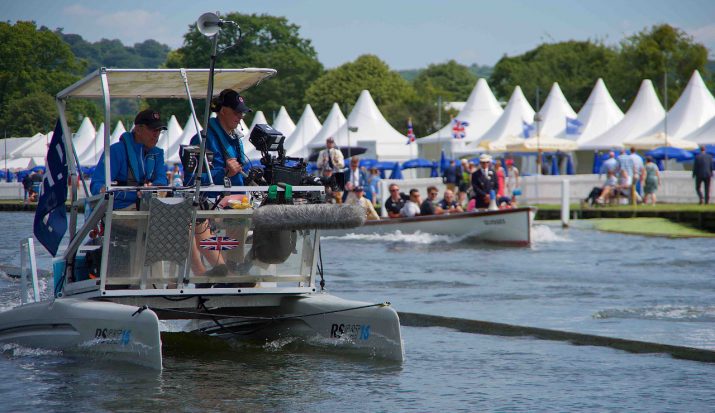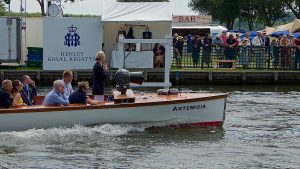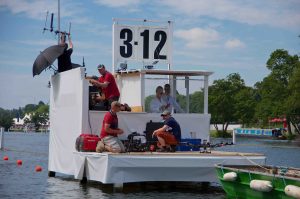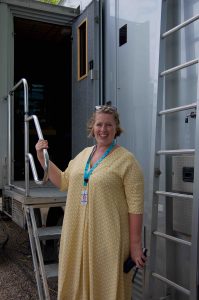Henley Regatta builds international audience with stylish production for YouTube and BT Sport

The Henley Royal Regatta is one of the grandest events in the English social calendar. A place to see and be seen – but, for 50 years, not by TV viewers. That was until five years ago when the Regatta brought in Sunset+Vine and started streaming every single race on YouTube. That partnership has now been extended for another five years.
“The uptick in entries has been dramatic because of the broadcast coverage,” with more races as a consequence, said Sir Matthew Pinsent, four-time Olympic gold medallist and Henley Steward.
“We’ve always had entries from Europe, America and Canada, but now we’re getting people coming from Australia and New Zealand in numbers that we have never had before and I think part of its to do with the broadcast initiative, and streaming it worldwide is key for that. The digital numbers aren’t huge, but they are significant because rowing is a small but passionate audience. Our average watch time yesterday on YouTube was over 20 minutes, which for YouTube is mad,” compared to a more usual 50 seconds average, he said.
“The digital numbers are significant because rowing is a small but passionate audience. Our average watch time yesterday on YouTube was over 20 minutes, which for YouTube is mad.”
The YouTube coverage is available each day, from early morning until the last race (about 19.45), and was the initiative of Olympian, Sir Steve Redgrave, chairman of the Regatta’s Committee of Management, when he took over running the regatta. Sunset+Vine then brought in BT Sport in the second year as it works with the broadcaster on football, rugby and cricket. BT Sport takes the last three days of the event and has signed up to broadcast it again in 2020.
“It’s been popular with the rowing community,” which is what is important to the organisers, said Andrew Preece, executive director, Sunset+Vine. There are some 350 races over the five days, with about 90 races on each of the first three days starting at five-minute intervals. “Every single race is streamed live on YouTube, and is clipped and available as an individual package within 20 minutes of the race.”
Preece feels that Henley is “a unique event. It is not just about sport, there is a lot more colour than normal races, and because it is a knockout competition there is a lot of emotion.”
One challenge for Sunset+Vine has been to protect the traditional view of Henley, uncluttered by

The gyro-stabilised Cineflex on the umpire boat Artemisia
cameras, and broadcast it without affecting the enjoyment of the annual 300,000 visitors to the Regatta, said Sarah Greene, Henley world feed executive producer (and head of women’s sport at Sunset+Vine). Although the Henley committee want to take the event forward, they are adamant that broadcasting it mustn’t interfere with the atmosphere and ethos of the Regatta.
“Part of Henley’s charm is that it is a very traditionally-led regatta, from a competition point of view. There is no data coming off that course. It’s all manual,” she said. “We have to be very mindful of that, and that is part of the USP of Henley, but we also have to keep pushing forward those quite surprising coverage moments we’ve been managing to get so far.”
Being on YouTube has been “a very definite and strategic decision, and I think, actually, they’ve been very lucky that they can play that long game. They will build organically from that and they will be in a much stronger position,” added Greene. The success of the coverage in increasing entrants from around the world, particularly from China, means that Henley is considering extending to a sixth day of racing, and Sunset + Vine is committed to covering it if they do.
The colour and excitement of the Regatta was enhanced this year with the King’s Cup, which Greene called “an amazing story”. This was only the second time it was rowed since its inception 100 years ago, and it won’t be rowed for another 100 years. The nations that competed in the original Peace Regatta came back, with the addition of military eights from Germany and the Netherlands, and Henley created a new King’s Cup using silverware from each nation (bits of boats or old trophies). It was also the first time mixed (male/female) eights took part in the Regatta. It was won by the US Naval Academy.
Depth of experience
There were two OB trucks at Henley – one doing the race coverage and the other the BT Sport presentation. This is the only rowing Sunset+Vine is currently doing. It did the Power8 Sprints last year in Bristol, but that hasn’t yet been taken further due to lack of sponsorship.
Even so, “we like to call ourselves the most experienced rowing production team in the world,” thanks to the sheer volume of races they have covered — 1,539 match-ups over the five years, said Greene. “We have had the same team, on the cameras, in the back room, in the truck, working on this regatta since we started.”
It has eight or nine race cameras, plus a roving reporter cam, and three cabled cameras for the BT Sport presentation. “It is not a huge camera plan, but it does give us pretty comprehensive coverage,” said Preece.
The first year they used all RF links, but now the three cameras near the finish line are on fibre. However, it is still a pretty big RF operation, linking back to receiver antennae by the finish.
“We wanted to create some variety, so that not every camera was panning from left to right,” he added. So, they spent a lot of time planning where to put camera gantries and other camera positions. “It is quite an interesting camera plan. It is quite varied.” The event is still being covered in HD, but UHD is on the agenda for what’s next.
“We’re always thinking of ways we can add more cameras and put new technology in, which is usually restricted by the budget,” said Preece.

The drone crew change batteries between races at Henley Regatta
The Henley organisation moves down the river during the Regatta, to give over its offices to the broadcast team, which is linked to the OB trucks by fibre. The live stream set-up is based in the boat shed, underneath the offices, with covered access to the four launches that service the broadcast operation.
It has three edit suites, while clipping of each race is done at Sunset+Vine’s offices in Hammersmith, London. There is also a highlights package for each day’s racing, and video news releases for local news use, and Sunset+Vine take care of Henley’s social media for the event. The BT Sport output is uplinked via satellite from the OB compound.
The boathouse is a 350m cable run from the OB trucks, and a 500m run from the Press Box, where the RF signals are received. There are also cables from the Press Box to the OB compound.
Everything has to go in early, because qualifying starts the weekend before, and be hidden from view. “If you walk around you can’t see any broadcast cabling, it all has to be in keeping with the Henley image, so we put in the BT Sport cabling in early June, late May,” which is hidden by all the tents, said Mark Dennis, head of technical operations, Sunset+Vine. It does all the cabling in the river and on jetties the week before racing starts.
“The amount of cabling we’ve had to put in and hide is quite unique. We’re proud that you can’t see any broadcast cabling if you are walking around.” In fact, the only noticeable broadcast infrastructure are the TV screens in the grandstands so visitors can follow the whole race, which Dennis feels has added to the excitement and spectator involvement as previously there was just a progress board to keep them informed.
Camera set up
Camera 1 is a jib on a pontoon at the start line, with transmission via cable to the south side of Temple Island, where there is a point-to-point RF link to the finish. “it is quite a powerful place to see everyone getting ready and psyching themselves up,” said Preece.
Camera 2 is a Cineflex gyro stabilised unit on the umpire boat, Artemis, which does one in five races following behind the rowers.
Camera 3 is on a small catamaran, with a purpose-built side mount. It covers every start and follows until the first mark. Preece hopes they can move this to an electric-powered boat to make it quieter and more environmentally friendly.
Camera 4 is on a hoist on the far bank sticking out over the river. Camera 5 is on a purpose-built platform in the middle of the river, while cameras 6, 7 and 8 are all Sony 4300s cabled, with fibre put into the river a week before the event. Both 7 on the finish line and 8 in the results box run in super-slo-mo mode. Camera 9 is a roving RF with multiple positions, including going out on a camera boat, and acts as BT Sport’s roving reporter cam.
Camera 10 is a Sony P1 with a 20:1 lens on a new Freefly Alta 8 drone. There are two drone platforms in the middle of the river. It did have a third platform, but didn’t use it much.
The drone “has a cracking lens on it, it’s got an extremely experienced pilot, who’s using that lens

Henley Executive Producer Sarah Greene in the OB compound
brilliantly, so we’re able to offer that view into the boat, and when we’re talking about how a cox is steering, or problems that they’re having, we’re actually overhead looking in to that boat and showing what they’re doing, what the feet are like, and the stroke rate, so we’re able to tell that story very differently,” said Greene. She thinks that like any sport that takes place at a distance from the spectators “the closer you can get the viewer to the nub of the action, the better. So, it’s a case of us using any bit of technology open to us to allow that to happen in, still, quite a non-intrusive way.”
It’s a big thing for the Regatta to have a drone flying up the course, “but they love looking at what it’s giving them,” she added. “It’s a real balance between protecting that USP and opening the Regatta up in all its glory to a much wider audience, but also technically to a rowing specific audience.”
“The drone’s been a game changer really. It has helped us have a variety of angles” – Andrew Preece, Sunset+Vine
“The drone’s been a game changer really. It has helped us have a variety of angles,” agreed Preece. The drones operate close to the crowds, so have an enhanced licence. The batteries are changed between races, and it covers every second race when they are at five minute intervals, or every race when they are every ten minutes (on the Saturday and Sunday).
There is also a dedicated ENG camera doing features for BT Sport and the world feed.
The production can also take the photo finish camera from Henley, when a race is particularly tight. Timing is less sophisticated than it would be for many international rowing races, but as each race involves just two boats, Preece feels that this doesn’t matter as much.
It has a crew of three doing all its digital elements, including live streaming, Tellyo Pro clipping, and digital-only features on YouTube. It also has a GoPro team, which puts GoPros on boats, using the recorded video for later edits and features.

HQ with a view: Mark Dennis on the balcony of Henley Royal Regatta’s offices
“We have 20 GoPros. You always have to put a GoPro on both boats, to be fair. As a boat comes in, we whip it off, take out the card, put a new card in, put it back on the next boat, so we can do as many boats as we can during the day,” explained Dennis. They manage to get them fitted for about half to two thirds of races – more when there are ten minute turnarounds.
They put them on the cox’s heads, or on the bow or stern, and generally lose one or so each Henley, but now fit them with float packs to get them back most times they come off. “A lot of the crews use GoPros now as a matter of course, and we do a lot of material sharing as well,” he added.
For live use “we are keen to work out how to get more onboard cameras on the boats, but the nature of Henley is there are so many boats, and so many different styles of boats, that how exactly the infrastructure works is difficult,” he said. However, adding any weight to a boat will always be an issue.
Next, Dennis is looking at the possibilities of using a wire cam. “It all depends on how strong an infrastructure I can put into the river” around all the piling put in each year to create the course. “It would be a nice continual shot,” following the boats as they come in to the finish.
As BT Sport offers UHD transmission, they would like to move to UHD, probably with HDR, which would certainly make the most of a sunny day on the river, if the Regatta organisers want to go that way. It has done some UHD shoots for Henley, but not live yet.
The Henley Royal Regatta 2019 was held from Wednesday 3 to Sunday 7 July 2019
